Several dilutions can alter the base coat colour of a horse. Dilutions lighten the coat and/or points (mane, tail, ear tips, lower legs). Some may also influence skin and/or eye colour. The different dilutions may affect red or black pigment only, or have an affect on both pigment types. When several dilutions are present in one horse, they might interact with each other and create new colours. Below are the dilutions that are available within Horse Reality.
¶ Cream
Cream is an incomplete dominant dilution, located on the same gene as pearl. In the heterozygous state, it dilutes red pigment to a yellow-gold colour, while black pigment is unaffected. When two copies of the cream allele are present, horses get diluted to a creamy white colour with pink skin and blue eyes. The names of the cream dilutions depend on the underlying base colour.
Heterozygous cream (CR/n):
- Palomino (e/e + CR/n) = A chestnut-based horse diluted by a single copy of cream. The body has a yellow-golden colour, mane and tail are creamy white.
- Buckskin (E/_ A/_ + CR/n) = Heterozygous cream on a bay base. The body gets diluted to a yellow-golden shade, but the black points are very slightly or not diluted.
- Brown buckskin (E/_ A/_ + CR/n) = Heterozygous cream on seal brown, much darker than buckskin. Mainly the soft parts of the body are diluted to a yellow shade.
- Smoky black (E/_ a/a + CR/n) = A black base coat with one cream allele. Smoky black is not distinguishable from black just by appearance.
| Heterozygous Cream (CR/n) - Pura Raza Española | |||

|
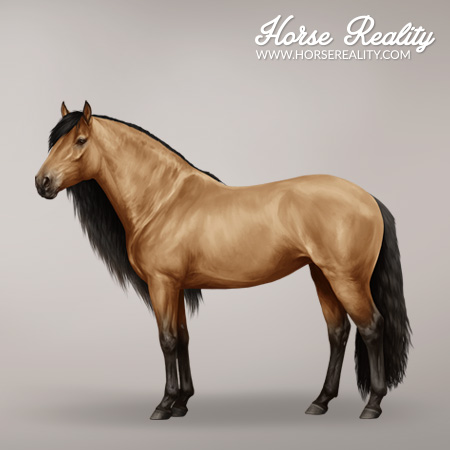
|

|

|
Homozygous cream (CR/CR):
Homozygous cream horses all have overlapping phenotypes, and can't be identified purely based on appearance.
- Cremello (e/e + CR/CR) = A chestnut-based horse with 2 cream alleles.
- Perlino (E/_ A/_ + CR/CR) = A homozygous cream on a bay base. The different bay shades can't be distinguished from each anymore.
- Smoky cream (E/_ a/a + CR/CR) = A black-based horse diluted by homozygous cream.
| Homozygous Cream (CR/CR) - Pura Raza Española | ||

|
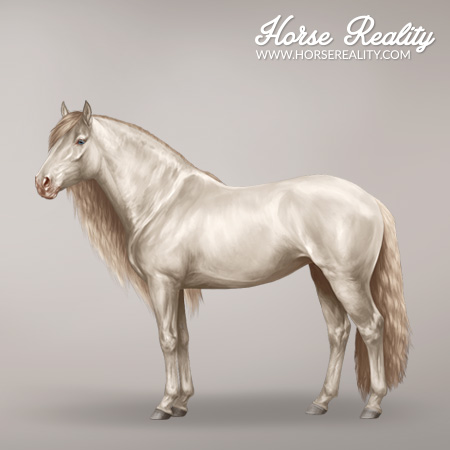
|

|
Since they are located on the same gene, cream also interacts with the pearl allele. Details about the resulting colours can be found under “Combinations of Dilutions”.
¶ Pearl
Pearl (prl) is a recessive dilution, located on the same gene as cream. Homozygous pearl affects both red and black pigment and lightens the coat, mane and tail. The skin is pink and/or mottled and the eyes are amber-coloured. Although recessive, horses heterozygous for pearl may have slightly lighter skin and/or small pale spots.
- Chestnut pearl (e/e + prl/prl) = A chestnut-based horse with pearl.
- Bay pearl (E/_ A/_ + prl/prl) = Pearl on a bay base.
- Black pearl (E/_ a/a + prl/prl) = A black-based horse diluted by pearl.
| Pearl - Irish Cob Horse | ||

|

|

|
Since they are located on the same gene, pearl also interacts with the cream allele. Details about the resulting colours can be found under “Combinations of Dilutions”.
¶ Dun
The dun gene has 2 alleles that can affect the coat colour of a horse: dun (D) and non-dun1 (nd1). Dun dilutes both red and black pigment and causes primitive markings. It mainly lightens the body while the head, lower legs, mane, tail and primitive markings of the horse are mostly unaffected and retain the underlying base colour. Primitive markings may include a dorsal stripe, leg barring, shoulder stripes, cobwebbing or face masks, and body stripes. Not all primitive markings are always present on each horse, and the degree to which they are expressed may also differ between horses. Dun can also cause frosting, light hairs on the sides of the mane and/or tail. Non-dun1 causes primitive markings, without a dilution of the coat. The dorsal stripe is usually the most apparent marking.
The dun allele is dominant. Non-dun1 is recessive to dun, but dominant over non-dun2 (nd2). Non-dun2 causes neither dilution nor primitive markings on the coat. The order of dominance is as follows: D > nd1 > nd2.
- Chestnut dun (e/e +D/_) = Dun on a chestnut base. The points and primitive markings have a darker red shade than the diluted body.
- Bay dun (E/_ A/a + D/_) = Dun on a bay-based horse. The body has a tan or golden body with dark points and primitive markings.
- Brown dun (E/_ A/a + D/_) = A seal brown horse with the dun dilution, much darker than bay dun.
- Black dun E/_ a/a + D/_) = Dun on a black base coat. The coat gets diluted to a greyish colour while the points and primitive markings remain dark.
| Dun - Irish Cob Horse | |||

|
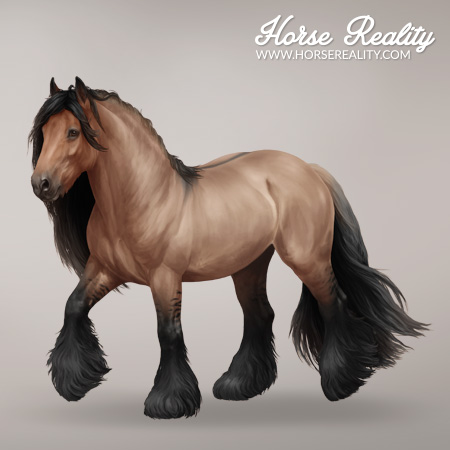
|

|
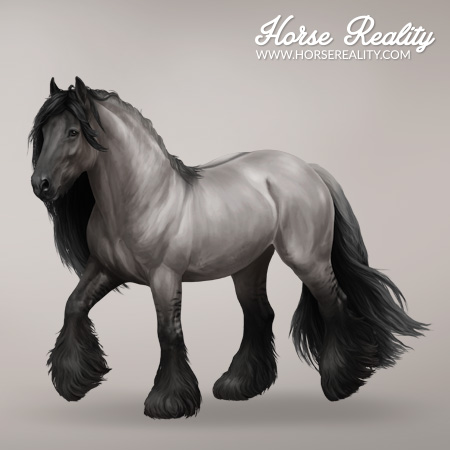
|
- Chestnut nd1 (e/e + nd1/nd1 or nd1/nd2) = Chestnut-based coat with non-dun1 have a darker red dorsal stripe or other primitive markings.
- Bay nd1 (E/_ A/a + nd1/nd1 or nd1/nd2) = Non-dun1 on a bay base creates a dark dorsal stripe and possibly other primitive markings.
- Black nd1 (E/_ a/a + nd1/nd1 or nd1/nd2) = The dorsal stripe or other primitive markings of non-dun1 may be hard to see on the dark, mostly undiluted black coat.
| Non-Dun1 - Namib Desert Horse | ||
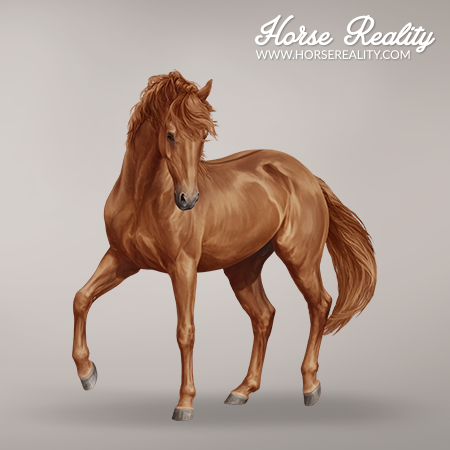
|
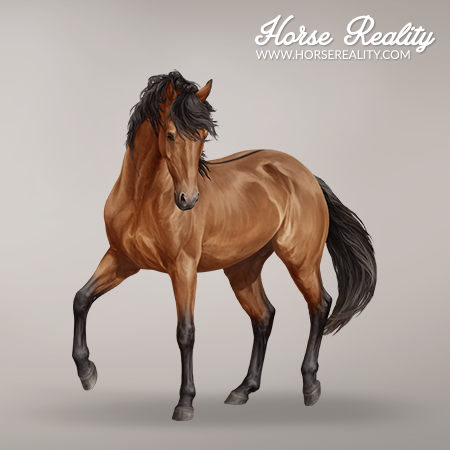
|
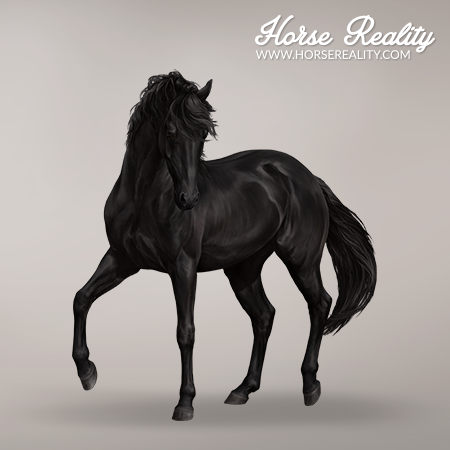
|
¶ Champagne
The dominant champagne (CH) dilution affects both red and black pigment. Red hair becomes gold, while black hair is diluted to a more chocolate brown. The skin colour of champagne horses ranges from pink to lavender. Champagne horses are frequently born darker than their adult colour will be. Foals are born with blue-green eyes, which darken to amber or hazel as the horse ages. Another typical characteristic is freckled skin. These small freckles can have a purple tone and start appearing in abundance as the horses age. They are particularly noticeable around the eyes, muzzle, under the tail, udder, and sheath. The colour champagne creates depends on the underlying base coat colour.
- Gold champagne (e/e + CH/_) = Chestnut-based, with a golden body and lighter mane and tail.
- Amber champagne (E/_ A/a + CH/_) = Champagne on a bay base. Horses have tan bodies, light brown manes and tails, and pink freckled skin.
- Wild amber champagne (E/_ A/a + CH/_) = Champagne on a wild bay-based horse.
- Sable champagne (E/_ A/a + CH/_) = Champagne on a seal brown-based horse.
- Classic champagne (E/_ a/a + CH/_) = Black-based. It creates a pale brown colour, with a tint often described as lilac, and darker points.
| Champagne - Quarter Horse | ||

|
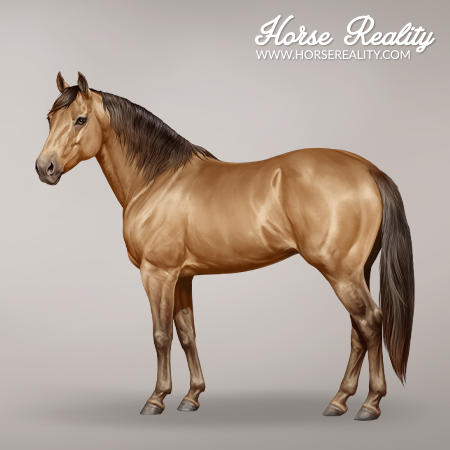
|
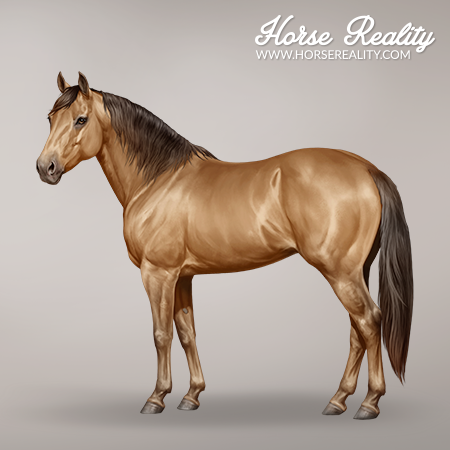
|
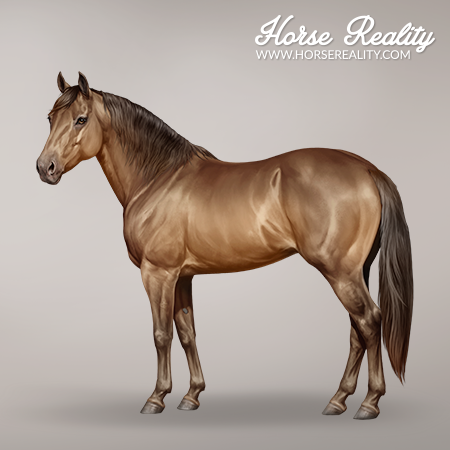
|
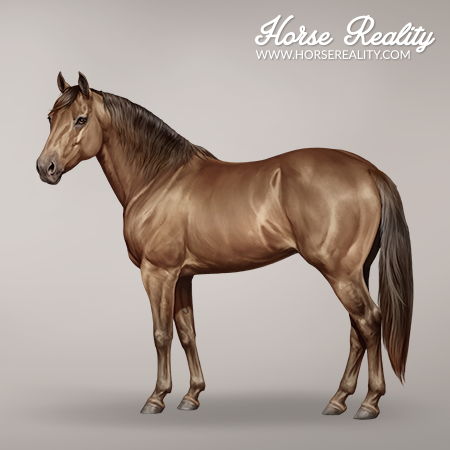
|
|
¶ Silver
Silver (Z) mainly dilutes the long hairs (mane, tail, feathering) of black and bay-based horses, the body is little to not diluted. It doesn't affect the colour of chestnut-based horses. Silver horses may have light eyelashes and coarse muzzle and facial hairs, but this rule has its exceptions. They can also have pronounced dappling on their coat. The eyes and skin are both dark. Foals are often very pale at birth, and then darken as they age. They may also be born with striped hooves, but these will also fade over time as the hooves grow.
The silver (Z) dilution is dominant. Both heterozygous and homozygous horses have the same phenotype.
- Silver bay (E/_ A/a + Z/_) = Silver on a bay base. It creates horses with a light mane and tail. They usually have lighter, brownish points.
- Silver brown (E/_ A/a + Z/_) = Seal brown horses with silver are much darker, with a light mane and tail. Since more black pigment is present on the coat, they may have a slightly diluted body.
- Silver black E/_ a/a + Z/_) = Silver on a black-based horse causes a black coat with a light mane and tail. The coat may get diluted to a more grey-brown colour and dapples are very common.
| Silver - Finnhorse | ||
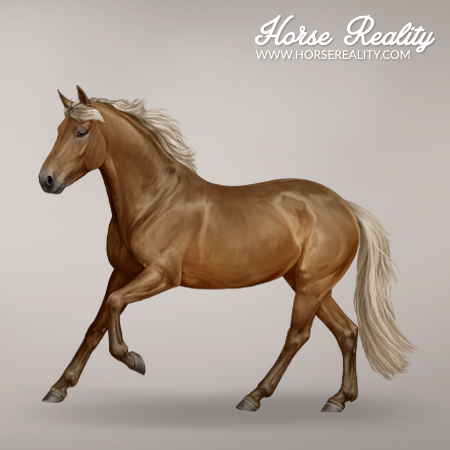
|
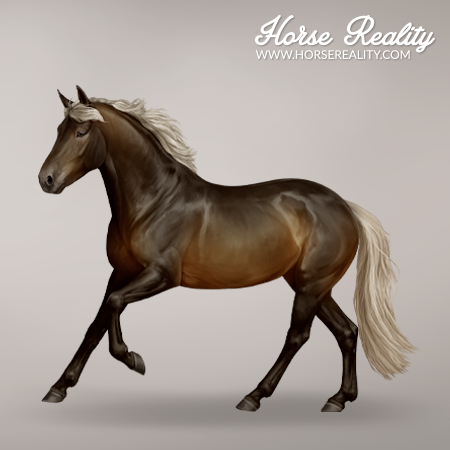
|

|
¶ Mushroom
Mushroom (mu) is a recessive dilution. Homozygous mushroom only affects red pigment. It dilutes the coat to distinctive “sepia” toned coat, often accompanied by a “flaxen” mane and tail. The coat colour can show a wide shade variation.
- Chestnut mushroom (e/e + mu/mu) = A chestnut-based horse with mushroom
- Bay mushroom (E/_ A/_ + mu/mu) = Mushroom on a bay base
| Mushroom - Shetland Pony | |

|

|
¶ Combinations of Dilutions
Horses can have multiple of the above-mentioned dilutions at the same time. When several dilutions are present in one horse, they might interact with each other and create new colours. These colours may also receive unique names. The most notable combinations are listed below.
¶ Cream + Pearl
Cream and pearl are located on the same gene. When one copy of each is present, the horse's coat is diluted to a cream colour similar to homozygous cream; therefore they are also often called “pseudo-double dilutes”. Cream pearl horses have pink skin and green/blue eyes, which are typically slightly darker than the eyes of homozygous cream horses.
- Palomino pearl (e/e CR/prl) = Cream pearl on a chestnut base dilutes the colour to a pale, creamy shade.
- Buckskin pearl (E/_ A/_ CR/prl) = Cream and pearl on a bay-based horse results in a light beige colour with points that look brown.
- Smoky black pearl (E/_ a/a CR/prl) = A black-based horse with cream and pearl. They have a more uniform tan colour with dark tan points.
| Cream Pearl (CR/prl) - Irish Cob Horse | ||

|
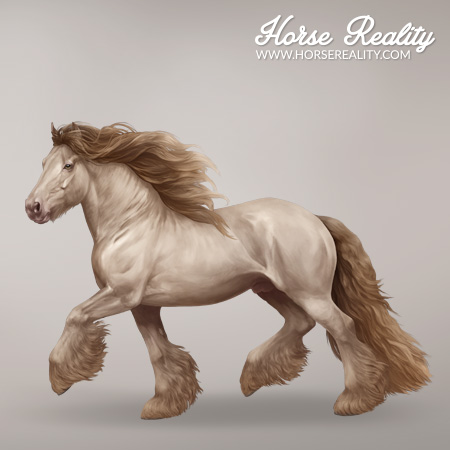
|

|
¶ Cream + Dun
When the cream and dun dilution are both present, the resulting colours often receive specific names:
- Dunalino (e/e + CR/n + D/_) = A chestnut-based horse that is heterozygous for cream (palomino) and that also has the dun dilution, is commonly called dunalino.
- Dunskin (E/_ A/_ + CR/n + D/_) = When a bay-based horse is both heterozygous for cream (buckskin) and has the dun dilution, this is commonly called dunskin.
| Heterozygous Cream + Dun - Quarter Horse | |

|

|
¶ Cream + Champagne
When the cream and champagne dilution are both present, the resulting colours often receive specific names:
- Gold cream (e/e + CR/n + CH/_) = Also called ivory champagne; a chestnut-based coat diluted by both champagne and heterozygous cream. The horse's coat lightens to an ivory colour. This coat can look similar to cremello; however, the eyes and skin will show the difference and have typical champagne characteristics.
- Amber cream (E/_ A/_ + CR/n + CH/_) = A bay-based coat diluted by both champagne and heterozygous cream. Wild amber cream is similar to amber cream, but the wild bay base causes the dark points to be restricted to pasterns or fetlocks.
- Sable cream (E/_ A/_ + CR/n + CH/_) = Champagne and heterozygous cream on a seal brown base. Sable cream champagne looks similar to sable champagne, only appearing a tiny bit lighter.
- Classic cream (E/_ a/a + CR/n + CH/_) = A black base diluted by both champagne and heterozygous cream. This colour can be hard to distinguish from classic champagne, it is often only a tiny bit lighter in colour.
- Homozygous cream champagne (CR/CR + CH/_) = Homozygous cream champagne horses don't appear to have visual champagne traits. Often they will have pink skin and pale blue eyes. Although they all look indistinguishable, terms such as “cremello champagne” may be used to specify the base colour of the horse.
| Cream + Champagne - Quarter Horse | ||

|
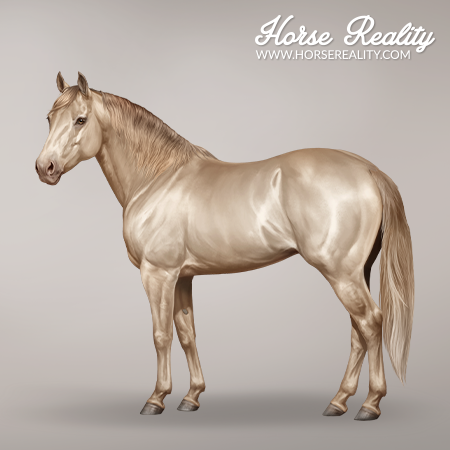
|

|

|

|

|
¶ Cream + Silver
While smoky black (black + heterozygous cream) has the same appearance as black; when the silver dilution is present, the 2 dilutions work together to create a horse that is entirely a caramel-like colour.
| Heterozygous Cream + Silver - Finnhorse |
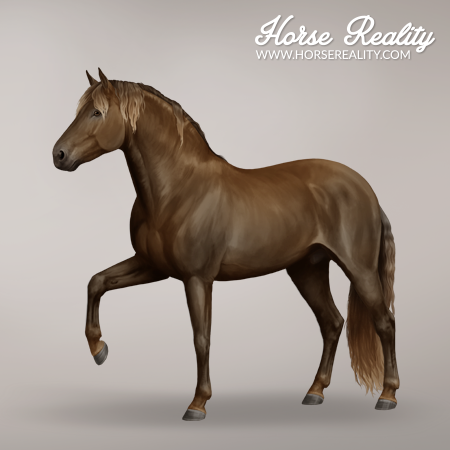
|
¶ Cream + Mushroom
On a bay base, the presence of heterozygous cream causes a more diluted mushroom coat, suggesting that cream and mushroom have an additive effect on bay-based coats.
| Heterozygous Cream + Mushroom - Shetland Pony |
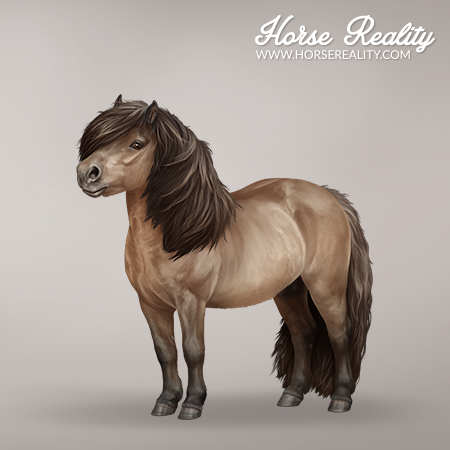
|
¶ References
- Bellone R., Sponenberg D. P., Equine Color Genetics, 4th Edition, 2017, Wiley-Blackwell
- Bowling A, Ruvinsky A., 2000, The Genetics of the Horse, 2000
- UC Davis Veterinary Genetics Laboratory; https://vgl.ucdavis.edu/; Access: December 2022
- Generatio Center for Animal Genetics; https://generatio.de/en/services/dna-tests-horses; Access: December 2022
- The University of Sydney, Online Mendelian Inheritance in Animals (OMIA); https://omia.org/OMIA001344/9796/; Access: December 2022